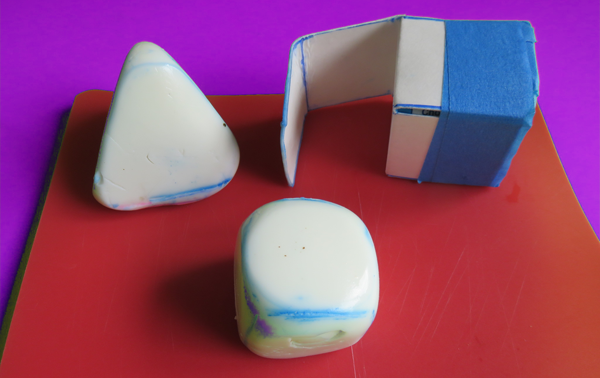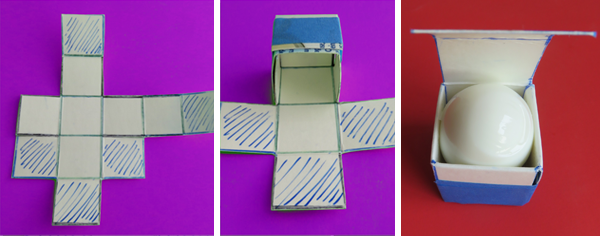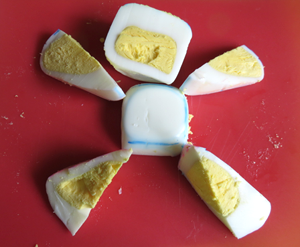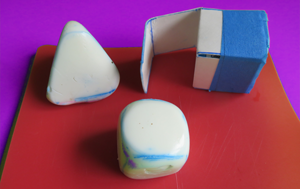What Shape is a Hard-boiled Egg?
Hard-boiling and dyeing eggs is a Spring tradition in many households. This year, give your hard-boiled eggs a twist and turn ordinary ovoid hard-boiled eggs into fun shapes! The trick to the transformation is understanding the science behind the process of hard-boiling.

Raw eggs are oval in shape. Hard-boiled eggs are made from raw eggs. Therefore hard-boiled eggs must be oval in shape, right? Your basic logic primer might suggest this syllogism is true, but a fun new science activity from Science Buddies lets families experiment with molding hard-boiled eggs into different shapes!
Once the hard-boiling process is done, many recipes for perfect hard-boiled eggs instruct you to immediately transfer the eggs to an ice bath. This can help stop the process so that the eggs stay beautifully yellow inside (rather than turning a more sickly green, a shade that also happens if you boil them too long).
As this new family science activity explains, if you remove the freshly hard-boiled (still very hot) egg from its shell and stuff it into a mold (like a box made from a milk carton), the egg will take on the new shape as it cools—and stay in that shape once you remove the cooled egg from the mold.

Sounds fun, right? Hard-boiled egg rockets (think cylinders and triangles), robots (stack those cubes), or whimsical animals (combine shapes) are just a scientific step away with this hands-on family friendly kitchen science activity.
You can find directions for this exploration here at Science Buddies in the STEM Activities for Kids area or at Scientific American:
- Shaping Hard-boiled Eggs (at Science Buddies)
- Shape-Shifting Science: Molding Hard-Boiled Eggs (at Scientific American)
If you try this family science activity at home, we would love to see what shapes you make with hard-boiled eggs this year!
Plating (Or Boxing) and Presentation
In the food industry, it is often said that presentation makes a big difference in how people perceive the food they eat. The same meal presented (or "plated") two different ways can strike people very differently.
 Even at home, you can see the idea that "presentation" matters play out in the preparation of school lunches. If you or your kids have ever spotted someone at school with a Bento-box style lunch, you may have seen foods cleverly cut, styled, and arranged into fun shapes or characters that turn everyday lunch materials into something creative, artistic, or unexpected. (Unfamiliar with Bento lunches beyond the idea of a Bento "box" container? Check this collection of Bento box lunch images for an inspiring glimpse of what is possible.)
Even at home, you can see the idea that "presentation" matters play out in the preparation of school lunches. If you or your kids have ever spotted someone at school with a Bento-box style lunch, you may have seen foods cleverly cut, styled, and arranged into fun shapes or characters that turn everyday lunch materials into something creative, artistic, or unexpected. (Unfamiliar with Bento lunches beyond the idea of a Bento "box" container? Check this collection of Bento box lunch images for an inspiring glimpse of what is possible.)
While we can't guarantee this science activity will singlehandedly help transform your lunch into cute pandas, Totoros, rabbits, or a Hello Kitty character, you can use molded hard-boiled eggs as a way to add more creativity and whimsy to your food presentation (or lunchbox packing)!
Students interested in the idea of food presentation may also be interested in the Perfect Plating: Which Food Presentation Technique is Best? * abbreviated project idea.
Fun with Eggs
For other experiments and family science activities that involve eggs (egg dyeing, egg boiling, egg launching), see this roundup: Family Egg Science. You (and your kids) won't want to miss the fun Ping Pong Catapult launching adaptation of the Bombs Away! project!
Categories:
You Might Also Enjoy These Related Posts:
- Star Wars Projects for May the 4th Be With You Science
- Spring Science Projects: 26 Science Experiments for Spring
- 5 STEM Activities with Marshmallow Peeps
- 6 Picks for St. Patrick's Day STEM
- 12 STEM Activities for Lunar New Year - Year of the Dragon Science
- Winter Science Projects, Lessons, and STEM Activities
- Make Some New Year's Noise with Science Projects!
- Holiday STEM Projects to Make and Give










